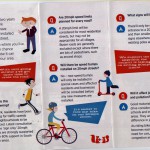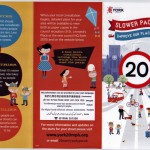The arguments about the introduction of a 20 mph speed limit across the whole of York seem likely to intensify with the publication and distribution by the Council of a highly misleading leaflet on the subject.
The cost of producing and distributing the leaflet is not revealed – a clear breach of the agreement that there would be transparency about such issues. Since 2001 all Council publications have included a line indicating publication costs. Generally publishing a leaflet and delivering to every household costs around £10,000.
The tone of the leaflet is highly patronising and seeks to mislead the public about the level of support for the 20 mph proposal.
It disingenuously quotes 80% support for a 20 mph limit in South Bank without revealing the number who responded to the consultation nor revealing that in 2009 – when the decision to implement a trial 20 mph limit in South Bank was taken – it was in the wake of speed surveys revealing that traffic speeds in the area were already well under 20 mph. The only issue was whether the large cost of putting up 20 mph repeater signs represented a prudent use of taxpayer’s money.
The introduction of 20 mph limits elsewhere in the country, where recorded speeds were already around 20 mph, resulted only in a 1 mph actual reduction in mean speeds.
It would be unsurprising if residents in the South Bank area, which is comprised mainly of relatively narrow terraced streets with large volumes of “on street” parking – which effectively slows traffic , would vote in a way which might be interpreted as encouraging vehicles to travel quicker.
Accident levels in the area were very low with no killed or seriously injured (KSI) victims recorded when the matter was considered in December 2009. There had been some minor accidents and it was hoped that the trial introduction of a lower speed limit would reveal whether these accidents could be eliminated. Prior to the approval of the trial in December 2009, there had been fifteen slight accidents in the previous ten years and five slight accidents in the previous three years.
What changed, was a decision by the new Council in 2011 to include Bishopthorpe Road in the trial. The shopping area might have been included as it was another section of highway where the daytime average recorded speeds were only around 15 mph. This is, again, hardly surprising given the location of the pedestrian crossing, traffic lights and road junctions together with high congestion levels at peak times.


